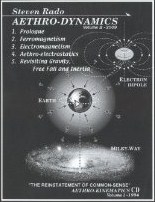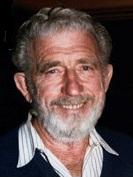Aethro-Dynamics (Buy Now)
The theory of an all-pervading physical Aether as forming a \'cosmosphere\' by its randomly moving constituents, the \'Aethrons\', producing an isotropic static pressure on every point of the Universe. The \'natural vorticity\' (Descartes) of this medium creates local rotations in the fluid which are condensed by the pressure and evolve into dynamic matter. The first permanent and encapsulated evolutionary unit is a \'donut-vortex-dipole\' equal to the modern \'electron dipole\', that continues to evolve in all magnitudes of atoms, molecules, solar-systems, galaxies, etc. The model of the Aether is based on the simplest form of Newton\'s mechanics, but declines his \'Universal Gravitational force\' by replacing it with a new force due to the \'Evolution of Matter\' thru the dynamic condensation of the Aether into subatomic, atomic and molecular systems, encapsulated into units by the cosmic pressure. Thus, \'matter\' is the condensation of rotational dynamics of Aether. All evolving matter consumes the cosmosphere and this procedure rarefying the Aether, that is, create a \'suction force\' produced by the inhalation of Aether by the cosmic bodies, feeding their internal evolution. Consider the following enigmas of present physics: Galileo\'s \'Inertia\' and \'Principle of Equivalence\' , Newton\'s mysterious identity of \'gravitational and inertial masses\' for explaining Galileo and saving his own derivation of the Kepler\'s formula. Coulomb\'s negative and positive fluid charges creating the neutrality of matter, instead of Franklin\'s much simpler an sensible \'one fluid\' theory with its \'surplus\', or \'deficiency\' on the electrified objects. Faraday\'s mysteriously visible magnetic and electric lines of forces in empty space and Maxwell\'s inability to build a model of Aether which forces him to a Langrangean mathematical detour and to postulate an enigmatic \'displacement current\' without a conveying Aether.? J.J. Thomson discovery of the first subatomic particle, named as \'electron\' and defined as a negative? charge carrier in one of Coulomb\'s two fluids. Rutherford discovered a second subatomic particle, the \'proton\' being 1836 times more massive than the electron, but inherits the \'same unit charge\' as the electron, but \'positive\'. Thus the proton became the nucleus of the Hydrogen atom, with one orbital electron. Einstein demolished all Aether theories, postulated that the speed of light is the limit of the motion of matter and discovered that the \'inertial mass\' of an object is increasing when it is approaching the speed of light. His gravitation is not a \'force\', but simply an \'acceleration field\', that is due to \'the effect of mass on geometry, as it curves? Euclid\'s straight line motion into orbits according to the inverse square law of action at a distance. 20th century physics finally concludes that protons are imprisoned in the nucleus and could not \'flow\' at all, thus the \'electric current\' is not the positive fluid of protons as Coulomb suggested, but the negative \'Electron Current\'. Nevertheless, the protons are still repelling each other with an immense force of repulsion in the tiny nucleus, therefore, to save the \'electrostatic model of the atom\' and Coulomb\'s whole theory had to be mathematically saved by the newest \'Standard Model\' of \'Quantum Mechanics\' by postulating an immensely \'Strong Nuclear Force\', which is just enough strong to cancel the protonic repulsion in the nucleus but short-range enough to leave a good old attraction field alive to keep the electrons on their orbits at 10.000 nuclei-diameters distance away in empty space...by \'action at a distance\'.? All these are described, explained and resolved here by Aethro-dynamics that is also contains a full CD version of the first volume; Aethro-kinematics for detailed history.



